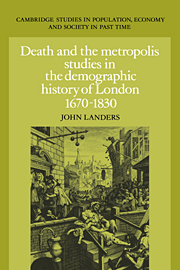Book contents
- Frontmatter
- Contents
- List of figures and maps
- List of tables
- Preface
- Acknowledgements
- Part I EIGHTEENTH-CENTURY LONDON AND ITS VITAL REGIME
- Part II THE LEVEL OF MORTALITY
- 4 Mortality among London Quakers
- 5 Mortality levels among the general population
- Part III DIMENSIONS OF LONDON'S EPIDEMIOLOGICAL REGIME
- Appendices
- Bibliography
- Index
- Cambridge Studies in Population Economy and Society in Past Time
5 - Mortality levels among the general population
Published online by Cambridge University Press: 05 November 2011
- Frontmatter
- Contents
- List of figures and maps
- List of tables
- Preface
- Acknowledgements
- Part I EIGHTEENTH-CENTURY LONDON AND ITS VITAL REGIME
- Part II THE LEVEL OF MORTALITY
- 4 Mortality among London Quakers
- 5 Mortality levels among the general population
- Part III DIMENSIONS OF LONDON'S EPIDEMIOLOGICAL REGIME
- Appendices
- Bibliography
- Index
- Cambridge Studies in Population Economy and Society in Past Time
Summary
The question of mortality levels among London's population at large returns us to the aggregate data contained in the Bills of Mortality. Although it would be a formidable – probably an impossible – task to determine the absolute shortfall in registration embodied in the latter such a labour is, fortunately, unnecessary, for the key demographic indices can be calculated without reference to such absolute levels, providing only that we can gauge the relative deficiency of baptism registration relative to that of burials. It would be rash to claim that even this ‘relative under-registration’ can be measured with a high degree of precision, but the work of Wrigley and Schofield (1981) provides us with a basis for such an exercise.
These authors developed correction factors intended for use with their national sample of parish register data, and although they incorporate material from the Bills, and the London Parish Register Abstracts, they do not bear directly on conditions in the capital, which are likely to have deviated from those in the country at large. Nonetheless, the figures have the advantage of a substantial empirical and analytical base, and any alternative ‘improved’ series would – given the material at our disposal – have a more uncertain foundation. Hence, rather than trying to adjust the Wrigley–Schofield factors to cater for the peculiar circumstances of London we shall – with minor exceptions – take them as they stand and then try to assess the general credibility of the vital indices obtained with their aid.
- Type
- Chapter
- Information
- Death and the MetropolisStudies in the Demographic History of London, 1670–1830, pp. 162 - 196Publisher: Cambridge University PressPrint publication year: 1993



